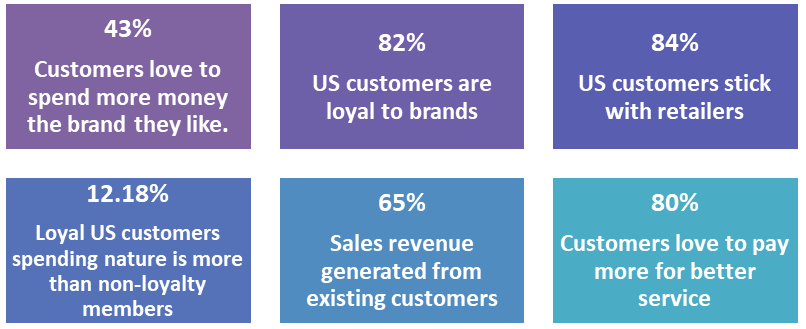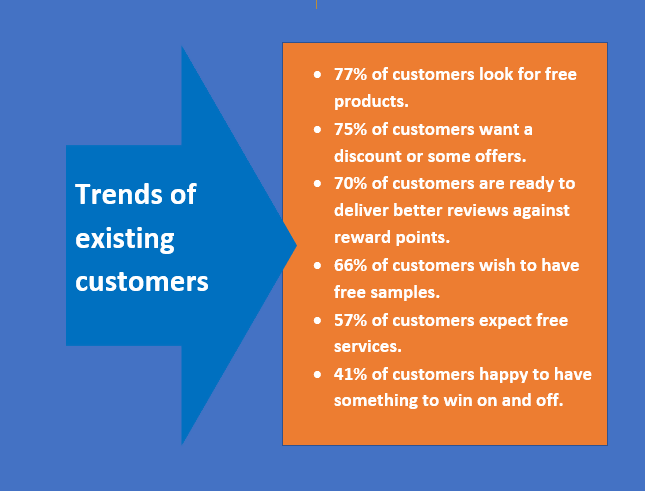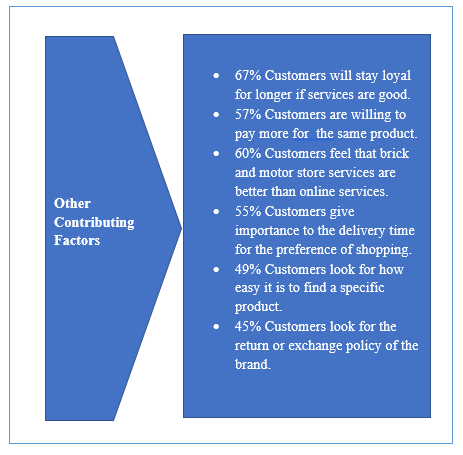Customer Retention Statistics And Facts For 2020

Customer retention is a critical element in business, and without customers, your business is dead. Maintaining an existing customer is much easy than identifying a new customer. So, it is imperative to retain the existing customers to make the business a successful venture, and managing the existing customers are very important for any business.
Retention of the customer depends on many factors, which eventually converge into the satisfaction quotient. A happy customer tends to come back again and again. A repeat customer not only will purchase himself/herself, but may also bring a couple of more customers. It happens so because of the referral publicity. All this will lead to an increase in the volume of sales, thus enhancing the company profit.
Overview of Customer Retention Statistics (2020 Report)
So, when a company gets repeated customer purchases, naturally, the company will have more profit, which is effortless attrition, due to the policy of the retention policy of the company. The reason for the retention could be a combination of many factors, from customer service to referral point programs. Repeat customer purchase is professionally known as customer retention. Basically, it is the indirect reward for the efforts applied by the company or a person to satisfy the customer to retain business.
If no effort has applied to retain customers, as many as 77% of brands can go out of business, and no one will notice, as opined by some experts. As per Adobe, the best 1% of customers are ready to spend 5 times more than an average customer. Loyal customers can pay up to 67% more than a new one as they will buy in larger quantities and frequent purchases.
Customer retention policy requirements:
First and foremost, the company has to try to give its best quality of products at the given price. According to research, it has found that when customers love what they buy, as much as 55.3% of customers will become loyal. Microsoft says that up to 77% of consumers are likely to prefer brands value and ask for feedback and incorporate them. They also suggest that 67% of customers feel that the standard of customer service has improved globally.
- 3% of customers will become loyal if they love the products they purchase.
- 77% of customers prefer brand value
- 67% of customers believe customer service has improved globally.
We need to remember that in today’s world, the customer is the king. So, we need to give our best to make this king happy and satisfied so he/she can spend a lot out of his pocket. Not only products need to be good, but other things matter too. Interaction and services are valuable assets in the industry.
Managing retention:

Big firms do have exclusive departments for managing customer retention. These people develop policies and marketing strategies to seduce and maintain the customer. It works as a honey trap, and the customer remains a loyal guest for an extended period. According to statistics, 65% of the profits will be from existing customers. According to Inmoment, 77% of customers stick with more than ten years loyal to the same brand.
- 65% of profits will be from existing customers.
- 77% of customers stick with one brand for more than 10 years.
As per the studies of Bond Brand Loyalty, when the rewards are more significant, people spend more to gain more rewards. Also, the customers continue to do business if there is a loyalty program associated with every purchase. Further, the purchasing tendency also suggests that people want to purchase reputed brands, which also covered with excellent loyalty programs. Rosetta supports these findings by saying that customers actively engaged with a brand are likely to make more purchases than an average buyer.
- 66% of people tend to spend to gain more rewards.
- 81% of customers continue to do business when there is a loyalty program linked with the products.
- 73% of people want to go with a reputed brand that offers an excellent loyalty program.
- 90% of customers satisfied with a brand likely to buy more than an average buyer.
HelloWorld goes ahead by mentioning that 75% of customers prefer being given rewards not just for their purchase but for other involvements too. Bond Brand Loyalty says that 87% of customers are willing to share details and interests if they are given some reward in return.
Some of the exciting brand loyalty statistics:

- 43% of customers love to spend more money on the brand they like.
- In the US, 82% of customers are loyal to brands.
- 84% of US customers stick with retailers.
- The spending natures of loyalty customers are 12-18% more when comparing to non-loyalty members.
- 65% of the sales revenue generated from existing customers.
- The cost of operating expenses can reduce by 10% if a company can retain 2% of its customers.
- 80% of customers love to pay more for better service.
What are the outputs?
Customer retention is beneficial to all customers as well as the company. Customers get excellent services, products, and deals while the company receives business, and in return, it can yield profits. It has further stated that if a company can successfully retain its customers, it can boost its profitability.
- If a company can retain 5% of customers, it can boost its profit by 25-95%
Express Matters suggest that a million-dollar company can earn $775 million by giving good quality experience to customers. Whereas FOBRES cautions that there can be a loss of as much as $75 billion because of poor customer services.
As quoted by AltFed, the probability of selling to an existing customer is much more than selling to new customers. When a customer comes back for shopping, it shows the trust established in the transaction. The repeat visit of the customer can lead to large orders time after time, which will be certain to reflect in the overall profitability.
The following are the finding of AltFed and Forbes:
- The profitability of existing customers is 60-70% more than new customers (AltFed).
- Based on the Pareto Principle, companies can make 80% of its profits from 20% of its existing customers (Forbes).
The findings of Nielsen on purchase tendency are very much interesting, and survey results show that more customers tend to buy products recommended by near and dear. In some instances, the purchase goes more than 4 times when a friend recommends a particular product.
- 92% of customers tend to buy products recommended by near and dear.
- The purchase manifold by 4 times when recommended by a friend.
- 18% of customers are more loyal than those who shop without any reference, as opined by the Journal of Marketing.
Important customer loyalty statistics:
Some of the vital customer loyalty statistics are as follows. It will give you an indication of the customer preferences and how they tend to react with retailers and brands. Customers are sensitive to brands and the service. They don’t mind paying extra for a particular brand because they consider the brand value, but there should be proper/adequate customer support service too.
The cost of the product should not be beyond their budget. Companies can retain a customer if they have a sympathetic policy by understanding their preferences and priorities. Prudence in brand furtherance is imperative to retain customers, or the importance of brand will gradually get diluted. Therefore, brand marketing also plays a vital role in staying live in the customers’ conscious.
- 25-125% profitability can increase if a company can reduce a 5% drop in the customer database.
- Identifying new customers will costs 5 times more than maintaining an existing customer.
- Customer loyalty to a particular brand is more, and 43% of customers love to spend more for the brands they like.
- 65% of the sales revenue generates from loyal customers.
- 57% of customers turn away from a brand if the negative review continues to exists.
- Half of the existing customers will stop buying if they face bad sales tactics.
- 42% of customers would not go with a brand that does not offer support service.
- 43% of customers will never come back if they don’t trust the company.
- 68% of customers will never show up because of poor customer service.
- 54% of customers won’t stick with a retailer who doesn’t offer coupons or other loyalty rewards.
Contribution of retention in business:
As said, many factors contribute to retention factor, out of which one of the most potent possibilities are the personal references. When a loyal customer shares their feedback with others who need similar products and refer the company from where he/she had the product, then naturally, that referral will help the new customer to reach the company. Referral customers are quality customers, and the chances of business conversion are higher than new walk-in customers. Adding new customers, while not losing the hold of old ones is a task in itself. American Express quotes that the potential of a single loyal customer of bringing in a new customer is as high as 11. Loyal customers act as magnets, as they bring in new and better customers.
Trends existing customers:

Doing all this is not that easy. It will require the company to come up with new schemes or deals, loyalty points, and their redemption, etc. These days the market has become very influential; people are concerned about what the other one has bought or is wearing. Customer review means a lot these days. Getting a positive review comment is a must.
As per the findings of Bond, the majority of customers want to give better reviews for the companies that are offering rewards points.
- 77% of customers look for free products.
- 75% of customers want a discount or some offers.
- 70% of customers are ready to deliver better reviews against reward points.
- 66% of customers wish to have free samples.
- 57% of customers expect free services.
- 41% of customers happy to have something to win on and off.
The trends clearly indicate the nature of customers, and it confirms that the purchased goods are not enough to retain the customers. When the customers get something extra as gifts, or rewards or loyalty points, it pays off as new business as they look forward to receiving more and more gifts and rewards each time of their purchase.
It is a competitive world. So, keeping customers happy is the key to reap success in business. The survey report of HubSpot is much interesting in this regard. The majority of the customers do not believe in the advertisements. It is an eye-opening to many companies, and they stopped investing too much on ads. Instead, they start to offer reward points to those who refer and bring more customers.

The trend in the market shows that offering gifts for writing a review or discount for referral service are widespread. It makes sense because in adapting such policy, the customer loyalty increases, and the existing customer stays with the company, and companies have realized that holding an old customer is inexpensive than seducing a new customer.
- 69% of USA customers do not believe in advertisements.
- 75% of customers shop at those companies from which they can get reward points.
- 82% of companies believe that retaining an old customer is less expensive than attracting a new customer.
After-sales customer service plays a significant role in customer retention. Microsoft suggests that 69% of customers rely on after-sales service while deciding upon loyalty towards a brand. BAIN also supports the above statement by saying that business raises 4%-6% for those who give better customer service. HubSpot too has the same observation that 93% of customers come back o the companies with outstanding customer service.
Excellent service will include quick response and faster resolution with a well-informed person to solve their problems. The customer must feel that ‘yes,’ his problem has been taken care of correctly and resolved on time.
Results achieved so far:
When we look forward to an example, it has found that in 2018, Amazon, Google, and Apple were the top 3 brands in the index of customer loyalty, according to Brandkeys. Business Wire says that up to 74% of millennials tend to shift brands when they receive bad customer service. American Express also supports this statement by saying that 50% or more orders may get canceled if there is bad customer service.
Gartner has stated that as much as 80% of existing profit can earn from only 20% of the existing customers. Nielsen has observed that as many as 89% of customers may be loyalty cardholders, but only 51% will continue to shop with you.
According to Iperceptions those company which has an experience-based business, they get an annual growth of around 15% as compared to only 11% for others.74% customers easily change their choice of brands for the way the purchase gets processed. The easier and faster is the delivery process, the more likely they are to buy. 32% may stop buying their favorite brand even after a single incidence of a bad experience.
Other contributing factors:

National sentiment also plays a significant role in maintaining loyalty. 90% of the people would like to buy from a local or national brand rather than others in the US, as quoted by Business Wire. But with changing needs and standards, as many as 50% of customers can shift to other brands for better fulfillment of their requirements, according to HubSpot.
Forbes has suggested that sometimes an emotional connect with the agent providing customer service can lead up to 86% customer retention. Microsoft also states that 65% of the younger generation aged between 18-34 years stay connected through media platforms for customer services. In the 2017 COLLOQUY LOYALTY CENSUS, it turns out that around 57% of Americans drop loyalty programs because the time taken to earn points is too long, they don’t like to wait.
- 67% of customers will stay loyal for longer if services are good.
- 57% are even willing to pay more for the same product.
- 60% of customers feel that brick and motor store services are better than online services.
- 55% give importance to the delivery time for the preference of shopping.
- 49% look for how easy it is to find a specific product.
- 45% depending on the return or exchange policy of the brand.
Factors that keep loyalty:
How do we determine who is loyal and who is not? Yopto has solved this for us. As they say that 37% of customers call themselves loyal after at least 5 purchases from the same brand. Accenture extends the view that 48% of people expect some sort of special treatment for being good customers. A P News goes further by stating that providing surprise gifts and offers is an excellent way to interact with the customers according to 61%customers.
In the coming year, according to Yotpo, 52% of American customers are going to start a new loyalty program with a preferred brand. Totalretail too says, that around 25% of new customers are going to join some form or other loyalty program based on delivery.
Extracts of the discussion:
From all the studies above, we get to know the importance of customer loyalty. With changing times, new challenges naturally expected to crop up any time, and that required due attention. The product quality still is the priority, but customer satisfaction and services are also just following as a major contributor in enhancing the sales.
Since many customers becoming tech-savvy, up-gradation of the company policy and system up to the market trend is essential to have sustainable business growth and sales revenue. Competition is rampant and challenging, so each step is equally important. There is no scope for a mistake, as it may cost dearly to the company. In current times emotional and personal aspects of the customer also have to be accounted for retaining customer loyalty.
People are swift to shift to other brands very quickly. This change may not be just once but occurs multiple times. The market is volatile; hence, the constant effort for retention is inevitable to maintain the business momentum. Better gifts and rewards can increase business volume. If customers can receive a discount for answering a survey or a testimonial, they will do it happily. So, small investments in these extra things will give more significant returns.
All we have to remember is that try to win the trust of your customer whatever it may take. Once there is trust, the business will become prosperous automatically. Business means profits, and customer retention plays a critical roll in holding existing customers, and holding them, the company can generate more business.
Reference links:
https://www.fundera.com/resources/brand-loyalty-statistics
https://zinrelo.com/loyalty-statistics
https://www.smallbizgenius.net/by-the-numbers/customer-loyalty-statistics/
https://blog.accessdevelopment.com/2019-customer-loyalty-statistics
https://www.saasquatch.com/blog/essential-customer-loyalty-statistics-for-2019/
https://blog.hubspot.com/service/customer-loyalty-statistics
https://smallbiztrends.com/2016/10/customer-retention-statistics.html
More To Explore
Wearable Statistics And Facts For 2021
Industry report Overview of Wearable Statistics And Facts For 20211
Facebook live Statistics, Usage And Facts (2020 Report)
Industry report Overview of Facebook live Statistics, Usage And Facts
Web Hosting Statistics, Market share And Facts For 2021
Industry report Overview of Web Hosting Statistics, Market share And
Explore Related reccomendations
Etsy Statistics, Users, Usage, Demographics (2021 Report)
- According to 0 users
Amazon Statistics, Sales Figures (2020 report)
- According to 0 users
Remote Workers Statistics And Facts (2020 Report)
- According to 0 users
SMS Marketing Statistics And Facts For 2020
- According to 0 users


